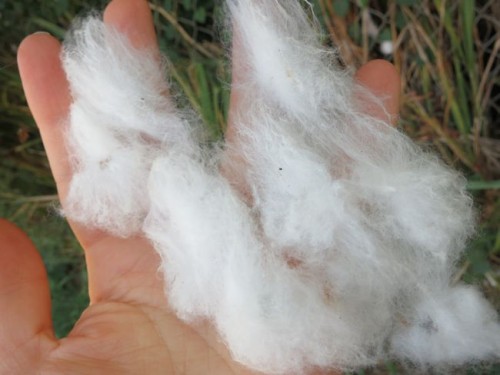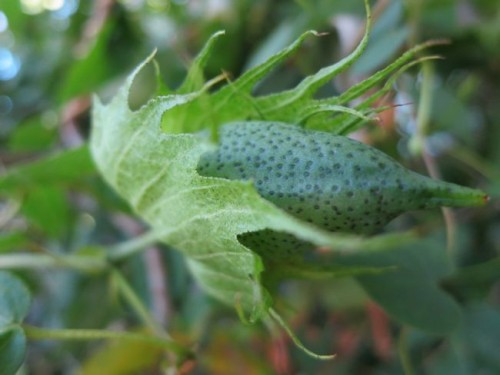As a child growing up in Hawaii I remember occasionally finding a cotton bush in someone’s yard, and being fascinated by them. I would pick the cotton and use it to stuff little dolls pillows. So I was aware of cotton in Hawaii, but it was definitely a novelty.
On my latest trip back I noticed cotton bushes everywhere: in yards and semi-wild along the road. Once again, I was fascinated. Had someone started a trend for cotton as a landscape plant? Had one bush seeded successfully across the island? Had the wet summer provided the perfect conditions to start a cotton boom?
I meant to stop and take pictures and investigate a bush so that I could tell you about it the whole trip, but there was always too much to do, and I was too busy. Then, on the way to the airport to fly home we stopped at a neighbors house, and there was a cotton bush. So here are my extremely rushed, 11th hour, cotton images.
The bush itself isn’t that attractive: it’s kind of weedy and scraggly looking. The overall impression with the bolls bursting forth with their snowy white interiors is quite striking though, so they look gorgeous as a background plant.
The bolls themselves are stunning, especially when they have just begun to burst, and are still held in tight ovals. The cotton is just so shiny and lustrous.
This may sound a little silly, but I was surprised by how cottony it was – I expected that all the treatment they give cotton would change the texture, but except for the horrible treated cotton balls they put in the top of medicine bottles (True story: I have to hand those to someone else to extract and discard, and I even leave the room while they do it), this stuff really felt like cotton.
I picked one nice boll of cotton fluff to try to bring back to NZ with me. I didn’t have much hope that DOC would let it in, but I hoped that if I pulled out all the seeds it might be OK – and it was! I declared it, explained, pulled out the sample and they were just fine with it. I’m so excited that I have a piece of untreated cotton I can show my students, without risking NZ’s fragile environment.
While it’s nice to have a bit of cotton here in NZ, it’s the prospect of cotton growing in Hawaii that have really got me thinking. The cotton was just growing wild, and was thriving. Surely that means that there is a potential to grow it more commercially?
I’m not advocating conventional cotton propagation in Hawaii, or even commercial organic cotton. These options are both are too water greedy and tilling intensive for Hawaii. Cotton is a very environmentally unfriendly crop, at least in the state it is currently being grown in. Organic cotton, for all its eco-hype is only marginally less un-sustainable, certainly not actually eco-friendly.
Perhaps Hawaii could create a space for truly sustainable cotton propagation. It would have to be very small scale, something scattered enough to avoid the pitfalls of mono-cropping, and the vagaries of Hawaiian rainfall. I’m envisioning a system where lots of people have one or two bushes in their backyard. The cotton could be processed and dyed locally, using natural local dyes. The resulting items would be costly, but Hawaii is so isolated that shipping in items drives up their cost considerably, making local products, even potential luxury ones like eco-cotton garments, more affordable in comparison.
Is it possible? I don’t know. Is it practical? It will be more so as the global cotton crop, and the global petrol supply, are put under more pressure. Will it happen? Watch this space?









I saw my first cotton plants on a drive from Philadelphia, Pennsylvania to Norfolk, Virginia. There were a couple of escaped plants growing near a rest stop, so my friend and I went to investigate. I was struck by how prickly those stamens are and how difficult it is to get the seeds out without scratching fingers. It made me appreciate how difficult the life of a cotton-field worker must have been even after the invention of the cotton gin.
Wow, I wonder if the cotton in Hawaii is different? The seeds are smooth and quite easy to pull out. The pod part that pops open is a little prickly, but not too bad.
I actually grow cotton – mostly colored heirloom/organic varieties. I use pretty much organic methods, by which I basically mean I weed them once a month by hand, and otherwise just let nature take it’s course. The heat in the SE US this summer killed off most of my seedlings, but I have a pair that managed to survive regardless. I’d say they aren’t necessarily that water greedy. They’ve been surviving largely off what’s fallen from the sky and the very rare watering. The problem stems more from the fact that you don’t get a whole lot out of them that way. The smooth-seed (Pima style) varieties produce a shorter staple length and generally less cotton overall. Same with colored varieties, which is why they are more expensive. They’re also harder to turn into something else on an industrial scale.
This is just something I do for crafty-fun, so it making money on it isn’t an issue. Neither is me actually having enough time to gin all of it, spin it, and then do something with it. Because I haven’t really done that either for most of what I’ve collected the last couple of years. 🙂
That’s interesting.
I think it’s neat that you now have a sample of cotton fiber straight from the plant. I did something similar once. When we visited Dover, England, back in 1990, I saw a white pebble on the ground and picked it up. The pebble turned out to be natural chalk (what the famous cliffs are mostly made of).
It now sits in a little leather pouch in my Viking sewing kit.
That is so cool! I’ve never seen a cotton bush before.
We have lots of milkweed here, which is very shiny and pretty, but it’s not a fiber you can spin. There are a lot of fiber farms in N.B. but they’re mostly sheep and goats.
A couple of cotton bushes in each yard sounds like a wonderful idea. I would love to participate in this local cotton project if I lived in Hawaii, or anywhere cotton grows. It sounds really fun, I’ve spun lots of wool but I haven’t tried any plant fibers before. I’m surprised by how long the staple looks.
Those cotton balls in the tops of medicine bottles do have a horrible texture, what do they do to them?
I was surprised by the same thing. I wonder if it’s specifically a long staple variety of cotton, I do know that such a thing exists. I’ve spun hemp and although I still favor wool (lovely floofy snuggly wool!) I would recommend trying some plant fibers out, they make an interesting change from animal fibers.
I wondered the same thing myself. Long staple cotton is the stuff they call ‘Egyptian’ cotton, though there isn’t really a standard as to how long it is. I know it’s mostly the short heirloom varieties that will self-seed and grow wild, so it would be quite exciting if a long staple cotton could grow wild in Hawaii.
There is actually a native Hawaiian cotton. It produces a very short brown boll – much too short to be commercially useful, but it has been very useful in cross-breeding with commercial cottons (particularly ones that will be grown organically) to improve natural insect resistance.
Can you spin that stuff on a spinning wheel?
I have no idea – I’ve never spun, and I forgot to ask my one friend on-island who spins if it was possible.
There are people who spin the short organics on a wheel, so it’s definitely possible, although I’m not sure how easy. My adventures into it have focused mostly on using a tahkli (Indian supported hand spindle geared specifically to cotton), although I’ve been meaning to try it on my wheel one of these days.
The stuff I found online about spinning it on the wheel focused largely on spinning off the seed, with hairy-seed varieties (like the kind grown all over SC, NC, and GA). I think with the smooth-seed variety you would likely need to make a puni first, which is basically just a tight rolag (like for wool).
Cotton needs a very high twist and is usually done long-draw style.
Thanks. Spinning is one of those things I’d like to try one day.